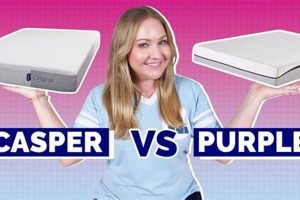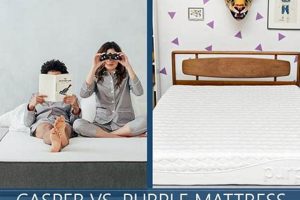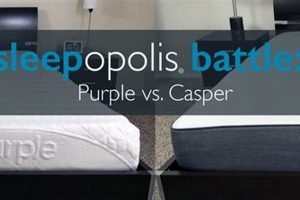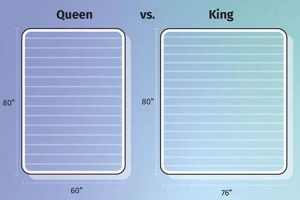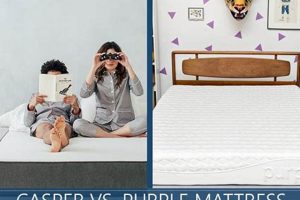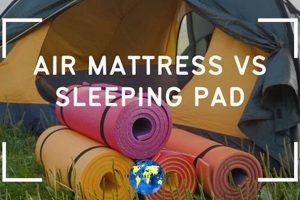A mattress protector is a fitted or encasement-style covering designed primarily to shield a mattress from spills, stains, allergens, and dust mites. These protectors often feature waterproof or water-resistant membranes. A mattress pad, conversely, is a layer of cushioning placed atop the mattress to enhance comfort. They typically offer a degree of protection, but prioritize adding softness or temperature regulation.
Maintaining a clean and hygienic sleep environment is crucial for overall health and well-being. The implementation of a barrier between the sleeper and the mattress minimizes the accumulation of allergens and potential damage from liquids, extending the life of the mattress. Historically, simple cloth coverings were used to protect mattresses, evolving into the sophisticated and specialized products available today.
The subsequent discussion will delve into the specific attributes, protective capabilities, and comfort characteristics of each product type, along with factors to consider when making a purchasing decision based on individual needs and priorities.
Guidance on Selecting Mattress Protection and Comfort Layers
Proper selection of mattress coverings enhances sleep quality and prolongs mattress lifespan. Consider the following guidelines to make an informed decision.
Tip 1: Evaluate Primary Needs: Determine whether the priority is protection from spills and allergens, or enhanced comfort and support. This will immediately narrow the selection process.
Tip 2: Assess Material Composition: Consider materials suitable for individual sensitivities. Hypoallergenic options are available for both protectors and pads, minimizing allergic reactions.
Tip 3: Examine Waterproofing Capabilities: For those concerned about spills or incontinence, verify the protector’s level of waterproofing. A quality protector should feature a breathable, waterproof membrane.
Tip 4: Consider Pad Thickness and Fill: If comfort is the primary concern, evaluate the pad’s thickness and fill material. Options include memory foam, down alternative, and natural fibers, each offering a distinct feel.
Tip 5: Review Care Instructions: Assess the ease of cleaning and maintenance. Machine-washable and dryer-safe options simplify upkeep and ensure hygiene.
Tip 6: Ensure Proper Fit: Confirm that the chosen product fits the mattress snugly and securely. An ill-fitting protector or pad can shift and compromise its effectiveness or comfort.
Tip 7: Understand Warranty Information: Investigate the manufacturer’s warranty for both types of product. Warranty coverage provides assurance regarding product quality and durability.
Selecting the appropriate mattress covering requires careful consideration of individual needs and preferences. Prioritizing protection, comfort, and material properties ensures optimal sleep quality and mattress longevity.
The subsequent sections will offer a comparative analysis to facilitate a comprehensive understanding and aid in informed decision-making.
1. Protection Level
The degree of safeguarding offered to the underlying mattress forms a primary point of differentiation between a mattress protector and a mattress pad. Understanding the nuanced levels of defense provided is critical in selecting the appropriate product for individual needs.
- Fluid Resistance
Mattress protectors, particularly those marketed as waterproof, are engineered to prevent liquids from penetrating the mattress. This is crucial in mitigating damage from spills, accidents, and bodily fluids. Mattress pads typically offer minimal fluid resistance, acting more as an absorbent layer than a barrier. In situations involving potential liquid exposure, a dedicated protector is demonstrably more effective.
- Allergen Barrier
Many mattress protectors are designed to create a barrier against dust mites, pet dander, and other allergens. This can be particularly beneficial for individuals with allergies or asthma, as it reduces exposure to irritants that can accumulate within a mattress. While some mattress pads may offer a degree of allergen protection, they generally lack the tightly woven construction and specialized materials necessary to effectively block allergens.
- Stain Prevention
Stains can degrade the appearance and hygiene of a mattress. Mattress protectors are designed to prevent stains from setting in, preserving the mattress’s original condition. Mattress pads may offer some incidental stain protection, but they are not specifically designed for this purpose and are less effective at preventing deep-set stains.
- Physical Barrier
Both mattress protectors and pads provide a physical barrier against wear and tear. However, protectors often offer more robust defense against friction, abrasion, and other forms of physical damage that can shorten a mattress’s lifespan. The durability of the protective material is a key factor in determining its effectiveness in preventing physical degradation.
In summary, while both types of products offer a degree of protection, mattress protectors are specifically engineered to provide a higher level of defense against fluids, allergens, stains, and physical damage. The choice between a protector and a pad hinges on the relative importance of these protective features versus the comfort-enhancing properties of a pad.
2. Comfort Enhancement
The augmentation of comfort constitutes a primary divergence point between mattress protectors and mattress pads. While both products overlay the mattress surface, their design philosophies and resultant effects on the sleep experience differ significantly. Mattress protectors, designed with a focus on safeguarding the mattress, often prioritize a low profile to minimize alterations to the existing mattress feel. By contrast, mattress pads explicitly aim to enhance comfort, typically through the addition of cushioning or specialized materials designed to regulate temperature or provide enhanced support. The choice between prioritizing protection versus comfort fundamentally influences the selection process.
The impact of material selection on comfort cannot be overstated. Mattress pads frequently incorporate materials such as memory foam, down alternatives, or latex to provide additional layers of cushioning and support. These materials contour to the body, alleviate pressure points, and contribute to a more restful sleep. Some pads incorporate cooling technologies or breathable fabrics to regulate temperature and prevent overheating. Mattress protectors, in contrast, often utilize thinner, less pliable materials to maintain a protective barrier. While advancements in textile technology have led to more comfortable and breathable protector options, their primary function remains protection, inherently limiting the extent of comfort enhancement.
Ultimately, the degree to which either product enhances comfort depends on individual preferences and priorities. Individuals who prioritize mattress longevity and protection from allergens or spills may find the minimal impact on comfort offered by a mattress protector acceptable. Those seeking a more significant improvement in sleep surface comfort may opt for a mattress pad, understanding that it may offer less comprehensive protection. Balancing these competing priorities is crucial in making an informed decision that aligns with individual needs and sleep habits.
3. Material Composition
The materials used in the construction of a mattress protector and a mattress pad directly influence their performance, durability, and suitability for different needs. Material composition dictates factors such as waterproofing, breathability, allergen resistance, and comfort level. Understanding the properties of various materials is crucial for making an informed choice between these two types of bedding accessories. For instance, a protector utilizing a polyurethane laminate backing offers superior waterproof capabilities, safeguarding the mattress from spills, while a pad filled with down alternative provides enhanced cushioning and comfort. Consequently, the selection of specific materials predetermines the primary function and capabilities of each product.
The selection of materials affects not only the functional aspects but also the longevity and care requirements of the product. Protectors employing tightly woven microfiber are better suited to preventing dust mite penetration, crucial for allergy sufferers. In contrast, mattress pads containing natural fibers like cotton or wool offer enhanced breathability and temperature regulation, important for ensuring comfortable sleep. The cleaning and maintenance procedures also depend heavily on the material composition. Washable protectors utilizing polyester blends allow for easy cleaning and maintenance, while pads with delicate fillings such as memory foam or down require specific care to preserve their integrity. The selection, therefore, is a careful balance between desired features, durability, and ease of maintenance.
In summary, the material composition forms a foundational element in distinguishing mattress protectors from mattress pads. The choice of materials governs the product’s protective capabilities, comfort characteristics, lifespan, and maintenance requirements. A mindful assessment of material properties allows for the selection of a product that effectively meets individual needs and preferences, optimizing sleep quality and extending the lifespan of the mattress. Disregard of material qualities may lead to choosing a product unsuited for its intended use or may compromise the products integrity over time.
4. Maintenance needs
Maintenance needs represent a critical consideration in the selection between a mattress protector and a mattress pad. The ease and frequency of cleaning, along with specific care requirements, directly impact the long-term usability and hygiene of these bedding accessories. Differing material compositions and construction methods dictate distinct maintenance protocols for each product type.
- Washability and Drying
The ability to machine wash and dry a mattress protector or pad significantly influences its practicality. Protectors, designed for frequent cleaning due to their role in preventing spills and allergens, often feature durable, machine-washable materials like polyester or cotton blends. Mattress pads, particularly those containing specialty fills like memory foam or down, may require spot cleaning or professional laundering to maintain their integrity and shape. The ease of laundering directly correlates with the frequency of cleaning, which is paramount for hygiene.
- Stain Resistance
The inherent stain resistance of a material affects the effort required for upkeep. Mattress protectors incorporating stain-resistant treatments or waterproof membranes simplify stain removal, requiring only a quick wipe-down. Mattress pads, especially those with absorbent natural fibers, may be more susceptible to staining and necessitate more intensive cleaning methods. The capacity to resist staining reduces the need for frequent or aggressive cleaning, prolonging the product’s lifespan.
- Durability and Longevity
The durability of materials dictates the frequency of replacement. Mattress protectors constructed from high-quality, tightly woven fabrics are less prone to tearing or degradation, even with regular washing. Conversely, mattress pads with delicate fills or loosely woven covers may exhibit signs of wear and tear more quickly, necessitating more frequent replacement. The expected lifespan of each product, coupled with its maintenance requirements, impacts its overall cost-effectiveness.
- Specialized Care Requirements
Certain materials necessitate specialized care procedures. Mattress protectors featuring waterproof membranes may require low-heat drying or air drying to prevent damage to the waterproof layer. Mattress pads containing memory foam or latex may require specific cleaning solutions or processes to avoid compromising their structure and performance. Adherence to manufacturer-recommended care instructions is crucial for preserving the product’s integrity and maximizing its lifespan.
In conclusion, the maintenance needs associated with a mattress protector versus a mattress pad represent a significant factor in the decision-making process. Evaluating washability, stain resistance, durability, and specialized care requirements ensures the selection of a product that aligns with individual lifestyles and preferences, contributing to a clean, comfortable, and hygienic sleep environment.
5. Cost variance
Cost variance represents a notable factor in the selection process when comparing a mattress protector and a mattress pad. The price differential often reflects the materials used, the complexity of construction, and the specialized features offered. Entry-level mattress protectors, prioritizing basic spill protection, typically exhibit a lower cost compared to elaborate mattress pads designed for substantial comfort enhancement. The presence of advanced technologies, such as cooling gels or sophisticated allergen barriers, contributes to a higher price point. Consequently, understanding the specific needs and aligning those requirements with the available budget is paramount. A seemingly inexpensive protector may prove inadequate if it lacks the necessary waterproofing, whereas a premium mattress pad may represent an unnecessary expenditure if basic comfort augmentation suffices. Therefore, a careful assessment of features and benefits relative to price is essential for informed decision-making.
The longevity of the product also influences the overall cost-effectiveness. A higher initial investment in a durable mattress protector constructed from robust materials may result in long-term savings by minimizing the need for frequent replacements. Conversely, a less expensive mattress pad may require more frequent replacement due to wear and tear, negating the initial cost advantage. Furthermore, the cost of cleaning and maintenance should be considered. A mattress pad requiring professional laundering will incur additional expenses over its lifespan, whereas a machine-washable protector offers a more economical solution. Consequently, a comprehensive cost analysis should extend beyond the initial purchase price to encompass the total cost of ownership, factoring in durability, maintenance requirements, and potential replacement costs.
In summary, cost variance is intricately linked to the features, materials, and long-term performance of mattress protectors and mattress pads. While initial price remains a significant consideration, a comprehensive assessment of durability, maintenance needs, and desired features is essential for making an informed and cost-effective decision. Neglecting these aspects may lead to selecting a product that fails to meet long-term needs or results in higher overall expenses.
Frequently Asked Questions
The following addresses common inquiries regarding the selection and utilization of mattress protectors and mattress pads, clarifying their respective roles and benefits.
Question 1: Is a mattress protector necessary if a mattress pad is already in use?
While a mattress pad offers a degree of comfort and may provide slight surface protection, it is generally insufficient as a primary defense against liquids, allergens, and dust mites. A dedicated mattress protector, especially one with waterproof capabilities, offers a more robust barrier against these potential hazards.
Question 2: Can a mattress protector alter the feel of a mattress?
Some mattress protectors, particularly those with thicker materials or quilted designs, may slightly alter the feel of a mattress. However, many modern protectors are designed with thin, breathable materials to minimize any noticeable change in comfort. Consider the material composition and thickness of the protector to mitigate potential alterations to the mattress feel.
Question 3: How often should a mattress protector and mattress pad be cleaned?
Mattress protectors should ideally be washed every one to two months, or more frequently if spills or accidents occur. Mattress pads can be cleaned less often, typically every three to six months, unless staining or soiling is apparent. Always refer to the manufacturer’s care instructions for specific cleaning recommendations.
Question 4: Are all mattress protectors waterproof?
Not all mattress protectors are waterproof. Some protectors are water-resistant, offering limited protection against spills, while others feature a waterproof membrane that provides a complete barrier against liquids. Verify the product description and specifications to ensure the desired level of waterproofing.
Question 5: Can a mattress pad improve the lifespan of a mattress?
While a mattress pad primarily enhances comfort, it can indirectly contribute to the lifespan of a mattress by providing a layer of cushioning that reduces wear and tear on the underlying mattress surface. However, a mattress protector provides more comprehensive protection against damage from spills, stains, and allergens, which are significant factors in mattress degradation.
Question 6: Is it possible to use both a mattress protector and a mattress pad simultaneously?
Using both a mattress protector and a mattress pad is a common practice. The protector is typically placed directly on the mattress to provide a barrier against liquids and allergens, while the pad is placed on top of the protector to enhance comfort and provide additional cushioning. This layered approach offers both protection and comfort benefits.
The key takeaway is that both items serve distinct purposes. A protector is for safeguarding your investment while a pad is mainly to improve the quality of your sleep.
The subsequent section will provide a concise summary encapsulating the primary distinctions and considerations when choosing between these products.
mattress protector vs mattress pad
This exploration has delineated the critical differences between a mattress protector and a mattress pad, emphasizing distinct functionalities. The former serves primarily to shield the mattress from liquids, allergens, and physical wear, thus prolonging its lifespan. The latter focuses on enhancing sleep comfort through added cushioning and support. Material composition, maintenance requirements, and cost considerations vary significantly between the two product types, impacting their suitability for individual needs.
The informed selection of either a mattress protector or a mattress pad, or a strategic combination of both, demands a careful assessment of personal priorities, balancing the imperative of mattress preservation with the pursuit of enhanced sleep quality. This decision should not be approached lightly, as it directly influences both the longevity of a significant investment and the overall well-being of the sleeper.


